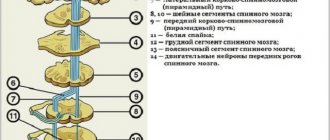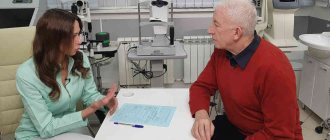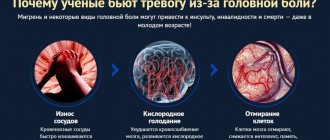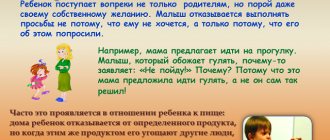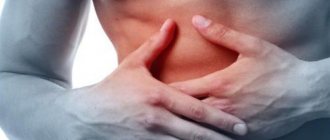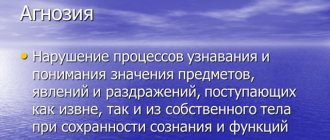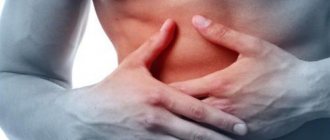Pain in the lumbar region is a fairly common occurrence. It can be caused by quite a variety of conditions. Pain in the lumbar region is recorded in the following pathologies:
- vertebrogenic and discogenic lesions of nerve roots;
- renal colic;
- pancreatic diseases;
- pathological changes in vertebral bone tissue.
The symptoms described by various authors, indicating pathology of the spinal disc segment, help to establish the cause of the pain syndrome, diagnose damage to the nerve roots and clarify the severity of the disease.
The most frequently studied phenomenon, which has diagnostic significance and also plays a role in determining the patient’s ability to work, is Lasegue’s symptom.
Mechanism of occurrence
In a normal state, in a healthy person, the nerve root is located freely in the intervertebral foramen, without tension and without causing pain when flexing the hip (except for some discomfort at extreme degrees of flexion).
Stretching of a nerve root becomes painful to one degree or another when it is pinched in the intervertebral foramen, as well as when it is stretched due to the convexity of a herniated intervertebral disc. In these situations, any strain while slowly lifting the lower limb will be painful.
A positive Lasègue symptom occurs when pain occurs when raising the hip less than 60 degrees. The appearance of discomfort or pain at an angle of more than 60 degrees may be a false-positive Lasegue symptom. This situation can arise even when examining a healthy person who leads a sedentary lifestyle or has reduced flexibility.
What diseases does a positive test indicate?
A symptom of tension may indicate the presence of the following pathologies:
- Herniated discs of the lumbar region, which protrude to the side and change the course of the nerve roots.
- Osteochondrosis. This pathology is accompanied by the formation of bone growths along the edges of the vertebrae, their displacement, as well as narrowing of the intervertebral foramina.
- Large formations near the nerve roots. These can be hematomas, tumors of various types, abscesses.
- Piriformis syndrome. With this pathology, the muscle in the obturator foramen of the pelvis spasms and puts pressure on the nerve, partially blocking its work.
- Lesions of the sciatic nerve, which are observed with diabetes, infections or intoxication of the body.
- Muscular-tonic syndromes.
- Myositis.
- Fetal pressure on the pelvic structures, which is observed in late pregnancy.
The test results are not a sufficient basis for making a particular diagnosis, as they may have a significant error due to the difference in the pain threshold of patients. It is for this reason that patients are additionally prescribed tests such as the Neri symptom or the Bekhterev-Fayerstein symptom. Based on all these tests, as well as additional studies, the disease can be accurately determined, and an adequate one can be selected.
How is Lasegue's symptom caused?
The symptom manifests itself when the lower leg is extended in a patient lying on his back with the hip flexed. The examination should be carried out carefully, without making sudden movements, since pain with a positive Lasègue symptom can be of high intensity. Lasègue's symptom is positive if pain occurs in the lumbar region, along the back of the thigh and lower leg of the corresponding side. Soreness is usually localized on the side of the affected nerve root. For example, Lasegue's sign on the right is caused by flexion of the right leg.
- The first phase of Lasegue's symptom: the occurrence or appearance of pain in a patient lying on his back when trying to bend or flex an extended leg at the hip joint.
- The second phase of Lasegue's symptom: if you subsequently bend the leg at the knee without straightening the hip joint, then the pain syndrome either disappears or its intensity sharply decreases.
An important point: it is not allowed to cause the Lasegue tension symptom after the use of anesthesia, since the protective pain reflex in such conditions is significantly reduced; manipulation in this case can lead to tearing of axons and cause motor disorders (up to paresis).
What does the symptom reveal?
The patient lies on his back. The extended leg is passively bent by the doctor to 70°. If sharp, shooting or burning pain occurs in the leg at an angle of about 45 degrees, the test, as mentioned above, is considered positive. The pain is caused by stretching of the nerve. When pain is detected at an angle of 60-70°, it is referred to as a pseudo-positive Lasegue sign.
Severe leg or hip pain should be considered muscle pain. The symptom may be aggravated by simultaneous internal rotation of the leg. Also, by rotating the foot, you can intensify the symptom (the so-called Bragar symptom). You need to measure the angle at which discomfort begins. Pain usually leads to a reflexive return of the limb to its original position. The nerve roots of the L4/L5 or L5/S1 segments are compressed during this maneuver.
The test may be positive for sciatica, disc herniation, meningitis, or subarachnoid hemorrhage.
If a patient experiences joint pain when the sprained leg is at an angle between 30 and 70 degrees, it is likely that the cause of the pain is a herniated disc.
A recent meta-analysis examined the information content and found that the test has:
- 91% sensitivity;
- 26% specificity.
If raising the opposite leg causes pain:
- sensitivity 29%;
- specificity 88%.
The test is usually performed on people with back pain to differentiate lumbago from sciatica. The test is not 100 percent reliable, but it usually gives a good and quick score. The test in medicine helps assess damage to nerve fibers. However, only a neurologist can make an accurate diagnosis. The test does not replace instrumental diagnostic methods, as well as conversations with a specialist. It is recommended to perform the test for informational purposes at home, and not for diagnostic purposes.
The Lasègue symptom has two variants:
- The first is the occurrence of pain along a vertical limb during passive elevation.
- The second develops by bending the limb at the hip and knee joints, and then straightening it. Similarly, a positive symptom manifests itself in the occurrence of sudden pain along the limb.
The diagnostic test is as follows: the subject lies supine with the pelvis stabilized. The doctor performs a passive leg lift on the patient. If the pain occurs in a non-physiological range, this means that the doctor is dealing with a radicular syndrome and, more specifically, with pressure on the sciatic nerve. The pain is caused by stretching of the SC nerves. Spinal nerves enter the spinal cord on the right and left sides of the spine. In most cases, the examination is repeated on the other leg.
The test can also be painful for healthy people if they suddenly lift their legs. However, if the pain occurs at a low altitude, then the result is said to be positive, which in this case means that the test gave a painful result. For example, a positive symptom may indicate a herniated disc, changes in the vertebrae associated with normal aging, or meningitis.
Meningitis
Advice! If a sharp pain reaction or other unfavorable manifestations (symptoms) occur while lying down, you should immediately consult a doctor.
If you have shooting pain on the left or right in the lower back, you should also contact a doctor after the experiment to clarify the cause. Self-treatment is not recommended. The test is not a final diagnosis, so the results should not be taken seriously. False-positive results are very common, so it is important to always confirm the diagnosis and symptoms with your doctor. Incorrect treatment can lead to irreversible and serious consequences, as can incorrect self-diagnosis.
Similar:
- The main symptoms of a hernia of the thoracic spine, the causes of the disease, methods of diagnosis and treatment
- The effectiveness of fitness for hernia of the lumbar spine, the causes of pathology, the rules of exercise therapy and general recommendations
- Causes of lumbar spinal hernia, prevention of complications, treatment methods for acute pain and symptoms
- Reasons why legs and lower back hurt, methods of diagnosis, treatment, prevention and prognosis of the disease
- Causes of foraminal hernia, symptoms, risk factors, diagnosis, complications and prevention methods
- What MRI data of the cervical spine show, indications, contraindications, preparation and information content of the examination
- Methods of treating intervertebral hernia of the lumbar spine without surgery, symptoms of the disease, complications and preventive measures
Interpretation of Lasegue's symptom
In the presence of a pathological process localized in the area of the nerve root, pain may appear when the hip is flexed at different angles (10, 15, 20, 30 degrees). The level at which Lasegue's symptom occurs allows us to judge the severity of the patient's condition and is of great importance for diagnosing the stage of the disease.
In order to track the dynamics of the clinical manifestations of a radicular lesion, it is advisable, when recording the examination results, to indicate the approximate angle at which the patient experiences pain (an example of such a recording: Lasegue’s symptom on the right is positive, 30 degrees). This will make it possible in the future, during repeated examinations, to compare the current result with the previous one and, based on the comparison results, make a judgment about the dynamics of the patient’s condition. In particular, an increase in the angle between the plane on which the patient lies and his thigh will indicate a gradual improvement in the patient’s condition.
How is diagnostics carried out?
If there are characteristic complaints, a medical history, a positive test for Lasegue’s symptom, as well as other neurological signs, the patient may be prescribed the following types of studies:
- radiography of the lumbosacral spine with functional tests (recently this method has been inferior to other imaging examinations);
- computed tomography or magnetic resonance imaging with contrast;
- electromyographic study (especially useful for diagnosing paresis, paralysis, innervation disorders);
When does a positive Lasègue symptom occur?
In neurology, this phenomenon belongs to the group of so-called tension symptoms; from the name it is clear that the formation of this diagnostic sign is associated with tension and tension of the nerve trunk.
- The most common case when a positive Lasègue symptom is observed is with osteochondrosis. Inflammation in the area of the nerve root leads to its compression and tension. Other symptoms of this group (Nery, Bekhterev) will also be positive.
- Acute discogenic lumbodynia. This condition occurs when the fibrous ring is torn, leading to protrusion of the intervertebral disc in the spinal disc segment. The cause of such a violation may be awkward movement in the lumbar spine, sudden lifting of weight. Clinically, acute discogenic lumbodynia is manifested by sharp pain in the lumbar region, often causing the patient to “freeze” in the position in which the pain syndrome found him. The duration of a painful attack is from half an hour to several hours. When diagnosing, an important role is played by the symptoms of Matskevich and Lasègue, the “board” symptom (impossibility of flexion in the lumbar region).
- Subacute discogenic lumbodynia. The reason is prolonged physical activity in a position that is uncomfortable for the patient (often in a bent state). Unlike the acute condition, subacute lumbodynia is characterized by a delayed development of pain.
Treatment
Prescription of treatment is possible only after identifying the cause of the complaints and a positive test. His approaches depend on the disease, its stage and the age of the patient.
For osteochondrosis, active forms of vitamin D, NSAIDs, chondroprotectors, calcium-sparing agents and, if necessary, estrogens are prescribed. These hormones prevent the development of osteoporosis. During the period of remission, manual therapy will be useful.
In the case of radiculopathy, muscle relaxants and non-steroidal anti-inflammatory drugs are used, which relieve swelling in the root area and relieve pain. During an exacerbation, traditional methods are not recommended to be used due to the risk of worsening the condition.
For hernias, conservative treatment methods are most often used (anti-inflammatory drugs, wearing corsets, chondroprotectors).
Surgery and traction are extreme measures.
Other diagnostic signs accompanying Lasegue's symptom
- Neri - the occurrence of pain in the lumbar region when the head is flexed.
- Matskevich's symptom is pain in the groin area and the anterior surface of the thigh when the patient bends the lower leg while lying on his stomach.
- Dejerine's symptom is increased pain when coughing or sneezing.
- Bekhterev's symptom (in a number of sources referred to as Lasegue's cross symptom) - when a lying patient sits down, his leg bends at the knee joint on the side of the nerve root lesion. If you straighten this leg, the healthy one will bend. In cases where a positive Lasègue symptom is recorded, ankylosing spondylitis' symptom is usually also positive.
- Lerrey's phenomenon - a pronounced increase in pain in the lumbar region in the event of a sharp transition from a lying position to a sitting position - is almost always a symptom accompanying the Lasègue sign.
Symptoms
The clinical picture will manifest itself due to disruption of the spinal roots and nerve endings in the sacral plexus.
Depending on the degree of tension, the symptoms are manifested by the following condition. The syndrome will be considered positive when, with the straight leg extended upward at a certain angle, intense pain is felt in the thigh or lower leg. As a result of the next phase, they pass or the severity decreases significantly.
Why can our articles be trusted?
We make health information clear, accessible and relevant.
- All articles are checked by practicing doctors.
- We take scientific literature and the latest research as a basis.
- We publish detailed articles that answer all questions.
The peculiarity of this condition is that the sensation of pain disappears when performing flexion movements of the hip or knee joint. This is explained by the fact that as a result of a decrease in tension, the roots begin to relax.
In medical practice, the following signs are identified that will indicate the presence of Lasègue syndrome in a patient:
- raising the lower limb will always be accompanied by severe pain;
- during the test, the skin in the thigh area on the outside numb
- when lifting the uninjured leg, pain will appear in the injured limb; this condition is called cross symptom;
- As a result of flexion of the joints, subside .
In the case when the pain does not disappear, they speak of a negative syndrome. In this case, there is a need to further identify the cause leading to unpleasant sensations.
What does this research method reveal?
There is a certain number of symptoms that associate pain in the back and limbs with inflammatory processes occurring in the spine. This group of syndromes is called tension symptoms. It is in this category that Neri's symptom falls.
Neri tension syndrome allows you to diagnose the following diseases:
- Myeloradiculopathy is an inflammatory process in the lumbar region, in which the L5-S1 nerve roots are pinched. As a result of this disease, a person’s sweating is impaired, and there is a decrease or complete absence of sensitivity of the skin. Laboratory testing of spinal cord fluid can detect the presence of leukocytes and red blood cells in the blood.
- Radiculitis is an inflammation affecting the spinal roots. The disease develops as a result of osteochondrosis and may be accompanied by the appearance of neoplasms and intervertebral hernias. Radiculitis also occurs as a result of previous injuries in the spinal column.
- As a result of hypothermia, spasm of the lumbar muscles occurs. This condition also affects the spinal nerves, which undergo elongation and compression. In this case, the syndrome also manifests itself.
- Osteochondrosis of 2, 3 and 4 degrees also causes the manifestation of this symptom.
